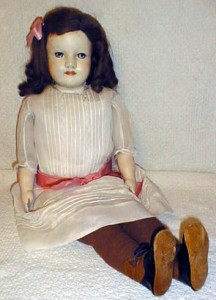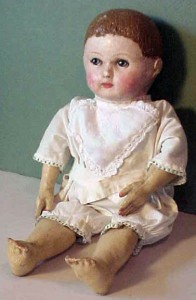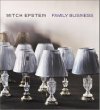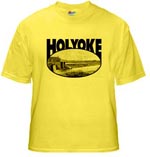by Laurel | December 17th, 2011
Gertrude Rollinson of 25 Morgan St, Holyoke, from 1916 to 1929, designed and made dolls for “crippled” children which she delivered to the hospitals at Christmas. The Utley Company (later the New England Doll Co.) bought the Rollinson patent and produced the dolls commercially from 1916 to 1922 when it went out of business. The dolls were 14-22 inches tall, had molded faces and were made as boys or girls. Features were painted. Hair was painted or wigged. Features included closed mouths as well as open mouths with teeth showing as the above doll. The dolls were said to have twenty coats of paint that were then sun dried and sanded to produce a washable doll. It also produced an amazingly smooth finish that completely belies the fact that the doll is made of cloth. Dolls were sold dressed and undressed.
Kiddiekins, appearing in 1921, ranged in size from 14-22 inches. It was distributed by several companies including George Borgfeldt, Strobel-Wilkins Co, Louis Wolf and Co. and Bailey and Bailey. It is not known who manufactured these dolls or if Gertrude Rollinson made them herself as The New England Doll Co. went out of business the next year. In 1929, a new doll by Rollinson appeared, the Bobby Lou doll. It was described as being from a “large family of Rollinson’s Bed Time Buddies” according to Edwards.
Prices for a Rollinson doll these days range from the hundreds to a couple of thousand, depending upon condition. Do a Google image seach and you will see other dolls.
17 December 1916
Attractive and Strong
Holyoke Product for Christmas Trade that has Remarkable Lasting Qualities
A great big lap-sized doll, beautiful as a fairy, life-life as a little girl’s own reflection in the mirror, strong as an ox — or an oxess — is Holyoke’s contribution to everybody’s Christmas in 1916. While a lot of high cost of living fiends have sat around moping over the impossibility of getting German dolls and the impossibility of making American ones, Mr. and Mrs. Turner Rollinson of Holyoke have gone ahead, invented, patented and put on the market at last on a big scale the Rollinson cloth doll. A few days ago the Utley company of Holyoke bought out the Rollinson’s patent rights and, with Mrs. Rollinson superintending the manufacture, are rushing though consignments for this year’s show counters.
Theoretically, the toy industry in America hadn’t any right to be stimulated until the war broke out and shut off all the “made in Germany” shipments. But Mr. and Mrs. Rollinson were ahead of the demand. Four years ago they had their idea of what the doll ought to be like, and three years ago they were actually in a small way producing.
Beauty, naturalness, high resistance power , are for doll the three essentials of a successful life, the Rollinsons reasoned in the days of the first experiments. The greatest of those being high resistance power. Now the rag dolls had that. they agreed. The rag doll could stand anything. But she looked like a fried egg. So the problem was to raise the rag doll to the standards of the front parlor loveliness. The Rollinsons did it so well that they won’t admit now there was any connections. But the fundamentals are the same, regardless.
A rag doll is just stuffing covered with cloth. So is a Rollinson doll. Only the Rollinsons went to work to find a cloth that would take paint like a complexion and would stand any amount of stretching; to find a stuffing that time could not dislodge nor anger dent. They found them both. But these things are part of the secret the new owners bought. There is cotton in the stuffing but that is all they have to say about it. Like Charles the First, of course, an ax can demolish it, but few tools less hefty can do the trick. And it submits, after Mrs. Rollinson’s designs, to an almost perfect molding of the features to realistic representations of every individual line in the nose, every curve of the cheek. Some day, if you stop in a department store to pat a little girl’s head and ask, “What are you doing here without your mother?” and she just goes on smiling at you, you may know that smile says “I’m a Rollinson.”
Adapted from The Springfield Republican, Cloth Dolls Ancient to Modern, by Linda Edwards, 1997, and photos from my personal archive.










